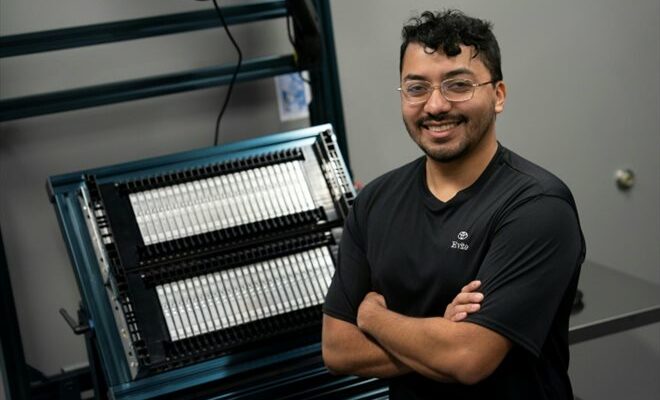Devante Cuthbertson, work-study apprentice at a Toyota factory, on April 22, 2024 in Greensboro, North Carolina (AFP/Allison Joyce)
When he was younger, Devante Cuthbertson thought he would one day have to leave his town of Greensboro, in the southeast of the United States, to find work, until the Japanese manufacturer Toyota decided to invest nearly 14 billion dollars to build a mega-factory for automobile batteries there.
At the age of 28, he completed an apprenticeship in a public technical education establishment, including three days a week of work for the manufacturer based in North Carolina, with the aim of landing a job there.
A flood of investments is pouring into the United States, where President Joe Biden is working to revive the industrial fabric and the supply chain in crucial sectors: batteries, semiconductors, etc.

The building of the Japanese manufacturer Toyota in Greensboro, April 22, 2024 in North Carolina (AFP/Allison Joyce)
In this presidential election year, he is also courting blue-collar voters in key states, those that can swing from one side to the other depending on the election, like North Carolina.
But Joe Biden also wants to undermine Chinese domination in energy transition technologies.
This is how a “battery belt” is expanding, especially in the southeast of the country – North Carolina and Georgia on the front line – with the establishment of battery factories for electric vehicles, and of components.
– Opportunity –
But with little unionism present in these regions, the Democratic president, who promised “good union jobs”, is under pressure and may not reap the benefits of this industrial boom.
Unions and civil rights organizations in Alabama and Georgia attempted in August 2023 to obtain worker rights protections from Hyundai.
The South Korean manufacturer has invested $7.6 billion in Georgia, notably to build an electric vehicle factory.

Sean Suggs, director of the Toyota plant in Greensboro, April 22, 2024 in North Carolina (AFP/Allison Joyce)
The prospect of creating hundreds, if not thousands, of jobs revitalized entire regions — including Greensboro and surrounding areas, which had thrived on the textile, tobacco and furniture industries.
For Devante Cuthbertson, the arrival of Toyota represented “an opportunity”, he tells AFP. That “of being part of something bigger than just a job. It’s a career”.
The workforce at Toyota’s gigantic battery factory is expected to increase from around 800 today to 5,100 people by 2028, and total investment to $13.9 billion. Originally, the manufacturer planned only 1.29 billion.
– Charging deficit –
Electric vehicles are expected to represent around 30% of the American market by 2030, notes Sean Suggs, director of this factory, but he is concerned about the lack of infrastructure, such as charging stations.

Employees of Kempower, manufacturer of fast chargers for electric vehicles, at the Durham factory, April 23, 2024 in North Carolina (AFP/Allison Joyce)
The American manufacturer Tesla has created its own network, which can now be used by several competitors, and the emergence of new players should improve the network.
The Finnish group Kempower set up in North Carolina two years ago, benefiting from funding from the American authorities to promote the development of the sector.
Nearly $650 billion in federal and local subsidies have been announced since 2021 to develop green industry (energy and manufacturing).
A flagship measure from Joe Biden, the Inflation Reduction Act (2022), must provide some $370 billion in aid and tax benefits to accelerate the energy transition, particularly on electric roads.

The Finnish group Kempower factory, manufacturer of fast chargers for electric vehicles, in Durham, April 23, 2024 in North Carolina (AFP/Allison Joyce)
Tomi Ristimaki, boss of Kempower, anticipates a lasting increase in financing for American and European manufacturers, with governments trying to crumble Chinese hegemony.
The company has invested more than $40 million in its Durham plant and created hundreds of jobs. It plans to source more than half of its needs from American suppliers.
– Patience –

Christopher Chung, director of the economic development organization for North Carolina, on April 23, 2024 in Raleigh (AFP/Allison Joyce)
North Carolina is attracting “almost unprecedented levels of activity,” notes Christopher Chung, director of an economic development organization in the state.
The American semiconductor manufacturer Wolfspeed has notably invested $5 billion in its new factory.
According to Mr. Chung, not only are these projects multiplying, but the average amounts invested are only increasing, as are their effects on employment.

Evito Perez, machinist at Toyota, on April 22, 2024 in Greensboro, North Carolina (AFP/Allison Joyce)
These companies will nevertheless have to be patient, because the electric vehicle market is developing less quickly than expected, and there is a shortage of qualified labor.
But the effects are already being felt on the ground, explains Evito Perez, a machinist at Toyota: “Schools are getting more funding than before, and many roads are being resurfaced.”
© 2024 AFP
Did you like this article ? Share it with your friends using the buttons below.




